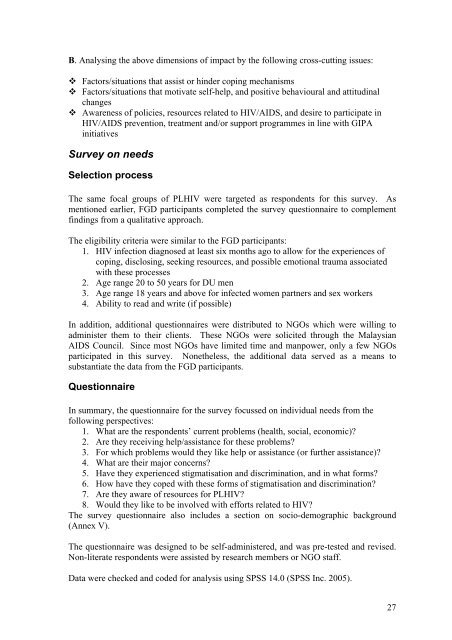Download this publication - AIDS Data Hub
Download this publication - AIDS Data Hub
Download this publication - AIDS Data Hub
You also want an ePaper? Increase the reach of your titles
YUMPU automatically turns print PDFs into web optimized ePapers that Google loves.
B. Analysing the above dimensions of impact by the following cross-cutting issues: Factors/situations that assist or hinder coping mechanisms Factors/situations that motivate self-help, and positive behavioural and attitudinalchanges Awareness of policies, resources related to HIV/<strong>AIDS</strong>, and desire to participate inHIV/<strong>AIDS</strong> prevention, treatment and/or support programmes in line with GIPAinitiativesSurvey on needsSelection processThe same focal groups of PLHIV were targeted as respondents for <strong>this</strong> survey. Asmentioned earlier, FGD participants completed the survey questionnaire to complementfindings from a qualitative approach.The eligibility criteria were similar to the FGD participants:1. HIV infection diagnosed at least six months ago to allow for the experiences ofcoping, disclosing, seeking resources, and possible emotional trauma associatedwith these processes2. Age range 20 to 50 years for DU men3. Age range 18 years and above for infected women partners and sex workers4. Ability to read and write (if possible)In addition, additional questionnaires were distributed to NGOs which were willing toadminister them to their clients. These NGOs were solicited through the Malaysian<strong>AIDS</strong> Council. Since most NGOs have limited time and manpower, only a few NGOsparticipated in <strong>this</strong> survey. Nonetheless, the additional data served as a means tosubstantiate the data from the FGD participants.QuestionnaireIn summary, the questionnaire for the survey focussed on individual needs from thefollowing perspectives:1. What are the respondents’ current problems (health, social, economic)?2. Are they receiving help/assistance for these problems?3. For which problems would they like help or assistance (or further assistance)?4. What are their major concerns?5. Have they experienced stigmatisation and discrimination, and in what forms?6. How have they coped with these forms of stigmatisation and discrimination?7. Are they aware of resources for PLHIV?8. Would they like to be involved with efforts related to HIV?The survey questionnaire also includes a section on socio-demographic background(Annex V).The questionnaire was designed to be self-administered, and was pre-tested and revised.Non-literate respondents were assisted by research members or NGO staff.<strong>Data</strong> were checked and coded for analysis using SPSS 14.0 (SPSS Inc. 2005).27















